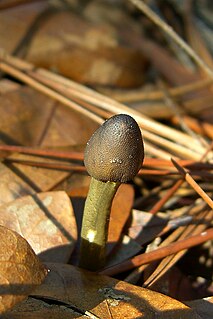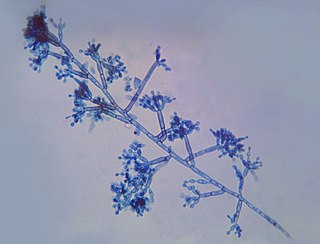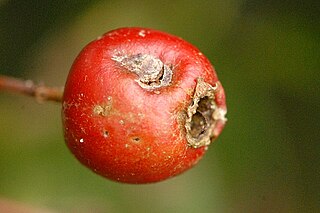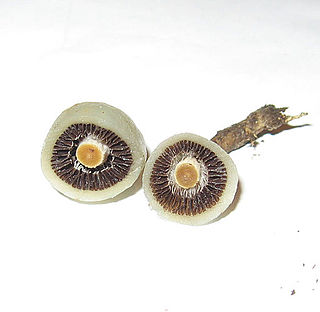Related Research Articles

The Cucurbitaceae, also called cucurbits or the gourd family, are a plant family consisting of about 965 species in around 95 genera, of which the most important to humans are:

Cordyceps is a genus of ascomycete fungi that includes about 600 species. Most Cordyceps species are endoparasitoids, parasitic mainly on insects and other arthropods ; a few are parasitic on other fungi. The generic name Cordyceps is derived from the Greek word κορδύλη kordýlē, meaning "club", and the Greek word κεφαλή cephali, meaning "head".

The APS underwater assault rifle is an underwater firearm designed by the Soviet Union in the early 1970s. It was adopted in 1975. Made by the Tula Arms Plant in Russia, it is exported by Rosoboronexport.

The Finnish Workers' Sports Federation is a Finnish amateur sports organization founded in 1919. In addition to the competitive sports, TUL focuses on youth activities and youth education as well as offering activities regardless of age, gender, ethnicity or financial means. TUL is one of the member associations of the Finnish Olympic Committee.

The Hypocreales are an order of fungi within the class Sordariomycetes. In 2008, it was estimated that it contained some 237 genera, and 2647 species in seven families. Since then, a considerable number of further taxa have been identified, including an additional family, the Stachybotryaceae. According to the Catalog of Life, As of April 2021 the Hypocreales contains 6 families, 137 genera, and 1411 species.

A diplococcus is a round bacterium that typically occurs in the form of two joined cells.

The Parmeliaceae is a large and diverse family of Lecanoromycetes. With over 2700 species in 71 genera, it is the largest family of lichen-forming fungi. The most speciose genera in the family are the well-known groups: Xanthoparmelia, Usnea, Parmotrema, and Hypotrachyna.

The Chaetothyriales are an order of ascomycetous fungi in the class Eurotiomycetes and within the subclass Chaetothyriomycetidae. The order was circumscribed in 1987 by mycologist Margaret Elizabeth Barr-Bigelow.

Helicobasidium purpureum is a fungal plant pathogen which causes violet root rot in a number of susceptible plant hosts. It is synonymous with Helicobasidium brebissonii (Desm.) Donk. It is the teleomorph of Tuberculina persicina which is its mycoparasitic anamorph.

The Venturiaceae are a family of fungi in the order Pleosporales. Several of the species in this family are plant pathogens.

The Pyronemataceae are a family of fungi in the order Pezizales. It is the largest family of the Pezizales, encompassing 75 genera and approximately 500 species. Phylogenetic analyses does not support the prior classifications of this family, and suggest that the family is not monophyletic as it is currently circumscribed.

Weraroa was a genus of mushrooms from the families Hymenogastraceae and Strophariaceae. The genus was initially described by mycologist Rolf Singer in 1958 to accommodate the single species Secotium novae-zelandiae reported by Gordon Herriott Cunningham in 1924. It was thought that the genus represented an intermediary evolutionary stage between a hypogeous (underground) ancestor and the related epigeous genus Stropharia. Advances in phylogenetics and taxonomic changes since 1958 found it contained unrelated species from multiple genera. It is now considered a synonym of the genus Psilocybe.
The Phaeosphaeriaceae are a family of fungi in the order Pleosporales. Species in the family have a cosmopolitan distribution, and are generally nectrotrophic or saprobic on a wide range of plants.

Gnomoniaceae is a family of fungi in the order Diaporthales. The family was circumscribed by German botanist Heinrich Georg Winter in 1886.
The Tubeufiaceae are a family of fungi in the order Tubeufiales of the class Dothideomycetes. The family was circumscribed in 1979 by mycologist Margaret Elizabeth Barr-Bigelow.
The Parmulariaceae are a family of fungi with an uncertain taxonomic placement in the class Dothideomycetes.
Massaria is a genus of fungi in the family Massariaceae.

The Chaetosphaeriaceae are a family of fungi in the Ascomycota, class Sordariomycetes. The family was circumscribed by Martina Réblová, Margaret Elizabeth Barr Bigelow, and Gary Samuels in 1999. Species in the family have a cosmopolitan distribution, and are found in both temperate and tropical climates. Fossils of the Chaetosphaeriaceae are known from the Carboniferous, Eocene, Oligocene, Miocene and more recent sediments.
Ormosia nobilis is a tree-forming plant species in the genus Ormosia. It grows in tropical South America, primarily in Bolivia, Brazil, Colombia, French Guiana, Guyana, Peru, Paraguay, and Venezuela. The Ormosis nobilis tree is known as "sirari" and it produces a commercial hardwood which is also known as sirari.
Fumago is a genus of fungi belonging to the family Capnodiaceae.
References
- ↑ Barr ME. (1979). "A classification of Loculoascomycetes". Mycologia. 71 (5): 935–57. doi:10.2307/3759283. JSTOR 3759283.
- ↑ Lumbsch TH, Huhndorf SM. (December 2007). "Outline of Ascomycota – 2007". Myconet. Chicago, USA: The Field Museum, Department of Botany. 13: 1–58. Archived from the original on 2009-03-18.
- ↑ "Fenestellaceae". www.gbif.org. Retrieved 11 November 2022.